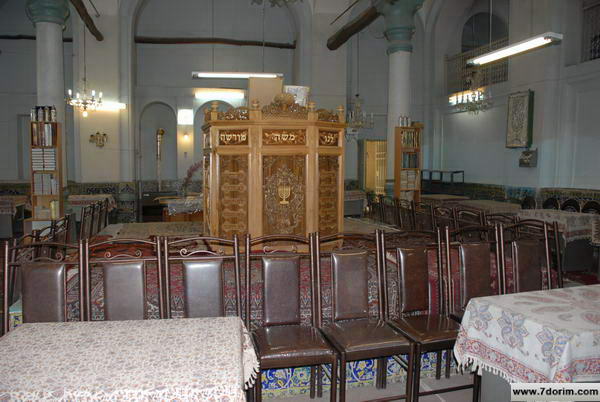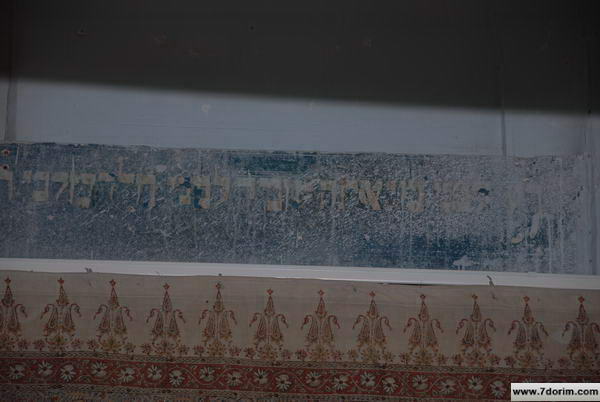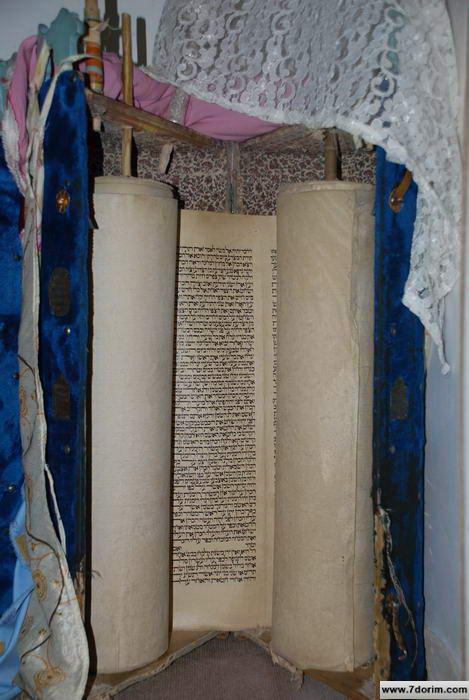Mollah Yaqoub Mary Synagogue, Isfahan, Spring 2011 (Molla Yaqoub)
To see 360-degree images (panorama), please click

Construction Date
The construction date of this synagogue remains uncertain, yet Mr. Shmuel Hai Reyhanian estimates it to be approximately a century old. Despite lacking an inscription, a key clue to its age lies in the pen-work curtain of the rabbi, bearing a Hebrew date from the late Qajar period. Unlike other synagogues, which tend to be difficult to distinguish from neighboring buildings, this synagogue stands out due to the destruction around it. Adjacent to it rests the tomb of Kamal al-Din Esmaeil, an Isfahani poet, now sheltered beneath a newly erected mausoleum. In the synagogue’s basement lie the tombs of several elders of Isfahan’s Jewish community, including the late Mullah Yaghoub, its original builder. These tombs have been carefully restored under the supervision of the Cultural Heritage Organization. Additionally, the synagogue itself underwent restoration by the Cultural Heritage Organization in 1998-99.
Architecture
Upon passing through the entrance door, we find ourselves in a corridor that leads to a 90-degree turn at its end, where a small octagonal vestibule emerges. From this vestibule, one path leads to the worship hall while the other leads to a small courtyard. The entrance to the worship hall is located at the southern corner of the eastern side. Interestingly, the entrance to the worship hall includes the women’s section too, functioning as a mezzanine attached to the building’s southern side.
The window positioned above the Torah Ark stands out as one of the most striking features of this building, meeting the religious requirement for a window oriented towards Jerusalem. As is common, natural light streams in through skylights, while decorative elements are limited to tiled walls and the leader’s stand. Inside the synagogue, we encounter “a space within a space” — or an “inner space” to use simpler terms — defined by four columns surrounding the leader. The building is extremely symmetrical and a sense of centripetal force, thanks to placement of the Torah Ark for which the congregation faces Jerusalem, serves as the sole element guiding the spatial orientation.

Mollah Yaqoub Mari Synagogue, Isfahan, Spring 2011

Mollah Yaqoub Mari Synagogue, Isfahan, Spring 2011

Mollah Yaqoub Mari Synagogue, Isfahan, Spring 2011
Within the precincts of this synagogue, after passing through its small courtyard, lies the tomb of Mullah Yaghoub and his disciples. They lived during the fanatical Qajar era. According to one account, after Mullah Yaghoub performed a miracle to prove the validity of his faith by reversing the flow of the Zayandeh Rud River, the ruler of the time killed him. When they attempted to burn his body, a snake coiled around the corpse and protected it until it was buried.

Mollah Yaqoub Mari Synagogue, Isfahan, Spring 2011

Mollah Yaqoub Mari Synagogue, Isfahan, Spring 2011
Judaism under fire
Habib Levi recounts this incident as follows: “In the era of Agha Mohammad Khan, the ruling authorities sought to compel the Jews of Isfahan to convert to Islam. The Jews had asked for a thirty-year respite. As the time had arrived for them to fulfill their promise, at that crucial juncture, Mullah Yaghoub stood as the spiritual leader of the Jewish community, and the authorities demanded that he honor the agreement.”

Mollah Yaqoub Mari Synagogue, Isfahan, Spring 2011
According to a historical account, Mullah Yaghoub declared, “We refuse, and I will prove the rightfulness of my faith to the challenger [who demands we convert].” He then instructed the Jewish community to fast daily until Friday and convened them, along with Muslims and their elders, at the Si-o-She-Pol Bridge. Facing the challenger, Mullah Yaghoub issued an ultimatum, “Either you command the river to halt, or I will. The one who succeeds shall be followed by the other.” The challenger opted for Mullah Yaghoub to take action.

Mollah Yaqoub Mari Synagogue, Isfahan, Spring 2011
According to a historical account, Mullah Yaghoub declared, “We refuse, and I will prove the rightfulness of my faith to the challenger [who demands we convert].” He then instructed the Jewish community to fast daily until Friday and convened them, along with Muslims and their elders, at the Si-o-She-Pol Bridge. Facing the challenger, Mullah Yaghoub issued an ultimatum, “Either you command the river to halt, or I will. The one who succeeds shall be followed by the other.” The challenger opted for Mullah Yaghoub to take action.

Mollah Yaqoub Mari Synagogue, Isfahan, Spring 2011
Crafting a sacred charm, Mullah Yaghoub cast it into the water, causing it to cease its flow. Turning to the challenger, he challenged him to restore the river’s flow. However, the challenger dismissed it as sorcery. The crowd divided, with Mullah Yaghoub’s Muslim supporters urging the challenger to respond with sorcery if Mullah Yaghoub’s command is indeed sorcery. Faced with resistance, the challenger relented.
Mullah’s confrontation
Mullah Yaghoub confronted him, questioning his persistence in harassing the Jewish community. The challenger responded, “I shall annul the thirty-year-old document and obtain a written statement from the Muslim mujtahid ordering us not to harass you again.” He returned the document and obtained a new one, which was also endorsed by Fath Ali Shah, and handed to Mullah Yaghoub. The new document remained in the possession of Asher Kadkhoda’s household.
Martyrdom
Mullah Yaghoub was assassinated some time later. Because of the grudge his opposition held against him for the miracle, they refused to let his body be buried and wanted to burn it instead. But a snake wrapped itself around his body and did not allow this to happen. Henceforth, he was given the title of Mullah Yaghoub Mari (“Mar” is Persian for “snake”).
Following his death, a severe plague struck Isfahan, causing heavy casualties. A man named Moshe Yehezkel Nakh Tab wrote a poetic biography of Mullah Yaghoub.
The historical accuracy of this account, which echoes elements of a tale reminiscent of Moses and his staff with its river water and protective snake, cannot be definitively established.
The Tombs
Although the historical accuracy of the story is questionable, the Jewish community in Isfahan also refers to Mullah Yaghoub as “Mullah Mari” based on this narrative, and visit his shrine to seek blessings from God.
Convergence of Iranian-Islamic art and Jewish heritage
The tilework adorning the tombs of these revered individuals is truly distinctive, blending elements of Iranian-Islamic art with symbols of the Jewish faith. Featuring intricate Eslimi designs, rich colors typical of Iranian tilework, and employing the seven-color method alongside prominent Jewish symbols like the Star of David and the seven candles, along with inscriptions in Hebrew script, these tiles possess a truly unique and captivating appearance.
Preservation
This building has been reconstructed and restored several times, both before the Islamic Revolution on the orders of Farah Pahlavi and after that with the help of benefactors and the Cultural Heritage Organization. Since this synagogue is one of the few large synagogues in the Jewish quarter of Isfahan, many gatherings, yeshivas, and religious ceremonies are still held there with traditional grace and are of particular interest to the Jewish community of Isfahan.
Sources
- Habibi Levi’s History
- Raphael Sedighpour’s MA thesis
- Pegah Naghreian’s BA thesis

Mollah Yaqoub Mari Synagogue, Isfahan, Spring 2011

Mollah Yaqoub Mari Synagogue, Isfahan, Spring 2011

Mollah Yaqoub Mari Synagogue, Isfahan, Spring 2011

Mollah Yaqoub Mari Synagogue, Isfahan, Spring 2011

Mollah Yaqoub Mari Synagogue, Isfahan, Spring 2011

Mollah Yaqoub Mari Synagogue, Isfahan, Spring 2011

Mollah Yaqoub Mari Synagogue, Isfahan, Spring 2011

Mollah Yaqoub Mari Synagogue, Isfahan, Spring 2011

Mollah Yaqoub Mari Synagogue, Isfahan, Spring 2011

Mollah Yaqoub Mari Synagogue, Isfahan, Spring 2011

Mollah Yaqoub Mari Synagogue, Isfahan, Spring 2011

Mollah Yaqoub Mari Synagogue, Isfahan, Spring 2011

Mollah Yaqoub Mari Synagogue, Isfahan, Spring 2011

Mollah Yaqoub Mari Synagogue, Isfahan, Spring 2011

Mollah Yaqoub Mari Synagogue, Isfahan, Spring 2011

Mollah Yaqoub Mari Synagogue, Isfahan, Spring 2011

Mollah Yaqoub Mari Synagogue, Isfahan, Spring 2011

Mollah Yaqoub Mari Synagogue, Isfahan, Spring 2011

Mollah Yaqoub Mari Synagogue, Isfahan, Spring 2011

Mollah Yaqoub Mari Synagogue, Isfahan, Spring 2011

Mollah Yaqoub Mari Synagogue, Isfahan, Spring 2011

Mollah Yaqoub Mari Synagogue, Isfahan, Spring 2011

Mollah Yaqoub Mari Synagogue, Isfahan, Spring 2011

Mollah Yaqoub Mari Synagogue, Isfahan, Spring 2011

Mollah Yaqoub Mari Synagogue, Isfahan, Spring 2011

Mollah Yaqoub Mari Synagogue, Isfahan, Spring 2011

Mollah Yaqoub Mari Synagogue, Isfahan, Spring 2011

Mollah Yaqoub Mari Synagogue, Isfahan, Spring 2011

Mollah Yaqoub Mari Synagogue, Isfahan, Spring 2011

Mollah Yaqoub Mari Synagogue, Isfahan, Spring 2011

Mollah Yaqoub Mari Synagogue, Isfahan, Spring 2011

Mollah Yaqoub Mari Synagogue, Isfahan, Spring 2011

Mollah Yaqoub Mari Synagogue, Isfahan, Spring 2011

Mollah Yaqoub Mari Synagogue, Isfahan, Spring 2011

Mollah Yaqoub Mari Synagogue, Isfahan, Spring 2011

Mollah Yaqoub Mari Synagogue, Isfahan, Spring 2011
A perspective on the cultural heritage of the Jews of Isfahan “Melai Yaqoub Mari Synagogue”


 فارسی
فارسی